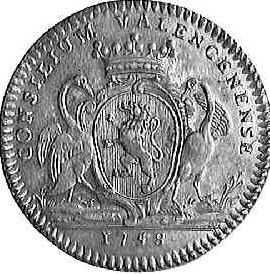
(A. C. Fox-Davies)

Usually, the stork (or crane=grue (French)) is shown holding a rock. The legend is that cranes lived on the banks of the Nile and were preyed upon by the Pygmees. To protect themselves at night, flocks of cranes would put one bird on watch duty, and that bird would hold a stone in its claws so as to be awaken should it fall asleep. The name of the stone, in French heraldry, is "vigilance" (vigilanza in Italian). The crane is presumed to be shown holding it, and it is named only if it is of a different tincture.

Because of the legend, the stork is often used as canting device by German families named Wachter, according to Woodward. Rietstap has a number of of families using a crane as a canting devices: Cramer, Cran, de Craen, de Crane, van Cranevelt, Crohn, Cronmann, La Grua (grù=crane in Italian), Karajan (see the page on famous musicians), Krahn, Krammer d'Obereck, Krane, Krehn, Krohen, Wachau, Wachter, Wacker, Wächter, Kiderlen-Wächter, Veillon de Beauregard (veiller = watch).
Some families with a crane in their arms:
From: Roger Forder <100523.201@CompuServe.COM>
Newsgroups: rec.heraldry
Subject: Swans in heraldry
Date: 19 Feb 1995 19:49:44 GMT
Organization: via CompuServe Information Service
Lines: 78
Message-ID: <3i87co$pv$1@mhade.production.compuserve.com>
As Francois Velde (13 Feb) gently pointed out, I had
indeed forgotten the "swan song" legend when I
expressed some surprise at the medieval connection
of heraldic swans with music.
He asked whether the "Tractatus de Armis" by Bado
Aureo (from which I quoted) includes any examples
of the arms of musicians. The answer is: not in
the extracts quoted by Rodney Dennys in "The Heraldic
Imagination", which is my only source at hand, but in
the near future I hope to track down the original
Latin text, of which I believe there is a modern
edition, and see what it says in this respect.
Looking through various other sources, I noted only
a few examples of musical swans in heraldry.
The arms of the Worshipful Company of Musicians (one
of the City of London guilds) include on the shield
"a swan with wings expanded argent". These arms were
granted in 1604, but there is evidence of previous use
of something rather similar. Full details can be found
in Bromley and Child's "The Armorial Bearings of the
Guilds of London" (London: Warne, 1960) - a truly
delightful book. It mentions the swan song legend.
In 1944, the London College of Music was granted
arms which included as supporters "swans rousant
proper charged on the wing with a harp azure".
(Briggs, "Civic and Corporate Heraldry")
"The Heraldry Gazette" for March 1994 has an account of
the arms granted to Sir Edward Heath, KG, the former
British Prime Minister and keen amateur musician. His
crest includes "a swan proper resting the dexter foot
on a covered gold cup". The explanation given was that
"the swan in the crest is taken from the Worshipful
Company of Musicians, of which he is an Honorary
Freeman, and refers to his many links with the world of
music", whilst the covered gold cup is a reference to
"his other livery comapny, the Goldsmiths, and to
trophies won for sailing".
Finally, just to show that in heraldry the obvious
derivation is not always the right one (or, at least,
not the whole truth), the crest granted in 1977 to the
Royal Philharmonic Orchestra is as follows: "Upon a
terrestrial globe azure, the land masses or, a swan
rising argent, gorged with an ancient crown and holding
in the beak an escallop or." Whilst at first sight
this would appear to be another straightforward example
of a musical swan - and this general connection may
indeed have been in the back of the herald's mind -
the (probably authoritative) explanation in "The
Heraldry Gazette" of November 1977 relates it more
directly to the eminent conductor and founder of the
RPO, Sir Thomas Beecham, whose crest included a "swan's
neck erased argent holding in the beak gules an
escallop or".
Now, these Beecham arms were actually granted to Sir
Thomas's father, Sir Joseph Beecham, who (as far as I
know) was not a musician but whose name was primarily
associated with "Beecham's Pills". I can therefore only
conjecture that the swan must be intended to recall the
famous crest of the medieval Beauchamp earls of Warwick
("out of a coronet gules a swan's head argent beak gules")
since "Beauchamp" is pronounced "Beecham". I wonder if the
escallop in the beak of Sir Joseph's swan is a reference
to the pills!
Sorry about such a long posting, but in heraldry one thing
just seems to lead to another!
--
Roger Forder
Guildford, England
100523.201@compuserve.com